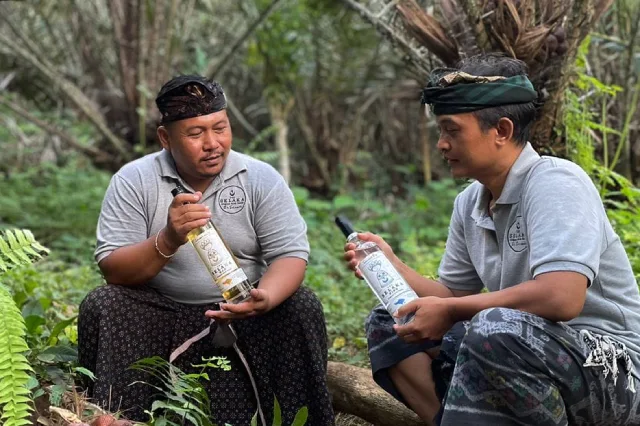Things to Do in Bali
Blue Krait in Bali (Malayan Krait)
The Blue Krait, known in Bali as Ular Weling or Lipi Poleng, and scientifically as Bungarus caeruleus, is renowned as the most venomous land snake on the island. Contrary to what its name suggests, this snake isn’t blue but displays distinctive black and white bands encircling its body, sometimes appearing in shades like dark brown, orange, or grey. This variability in coloration can make it tricky to identify, often leading to confusion with less dangerous species.
One of the defining features of the Blue Krait is the larger scales along its spine, which stand out compared to its other scales. However, recognizing this detail means being dangerously close, which is not advisable. The Blue Krait is nocturnal, becoming active at night, particularly after rainfall. It typically roams the outskirts of buildings, hunting for lizards and rodents. These snakes have a strong aversion to bright lights, often retreating when exposed to a flashlight or other light sources.
What makes the Blue Krait particularly perilous is its potent neurotoxic venom, capable of causing paralysis and respiratory failure. The bite itself is deceptively painless at first, with symptoms developing gradually. There is no specific antivenom for Blue Krait bites, but timely medical intervention can manage the effects, such as providing ventilatory support until the venom’s impact diminishes.
Encounters with the Blue Krait are rare but serious. This snake’s combination of elusive behavior and deadly venom underscores the importance of caution and respect for Bali’s diverse wildlife.
Blue Krait
- Latin Name: Bungarus caeruleus
- Bahasa Name: Ular Welang Biru
- Length: Up to 1.75 meters
- Danger Level: Highly dangerous, but generally non-aggressive
- Venom: Possesses highly neurotoxic venom that can cause paralysis and respiratory failure. Bites are dangerous but relatively rare.
- Color: Black or dark blue with thin white bands
- Specific Markers: Slender body with less distinct banding. **Eye Shape:** Round pupils. **Head Shape:** Slightly distinct from neck, not very broad. **Eye Color:** Dark.
- Habitat: Near water bodies, including streams and paddy fields
- Activity: Nocturnal (night active)
- Prevalence: Rare
- Region: Lowland areas and near human settlements
- Behavior: Nocturnal and secretive, Blue Kraits are generally non-aggressive and tend to flee from human contact. They are more likely to bite if handled or threatened.
- Encounter Risk: Low. Due to their nocturnal habits and tendency to avoid humans, encounters are infrequent. Bites usually occur when the snake is accidentally stepped on or handled.

Source: Wikimedia Common
Conservation Status of the Blue Krait (Bungarus caeruleus)
Least Concern (LC) globally. In Indonesia, it is common in suitable habitats. Overall, the Blue Krait’s conservation status reflects a species that is relatively well-adapted to its environment and not currently at risk of extinction, though continued monitoring of its population and habitat is essential.
What Travelers want to know about Snakes in Bali
Yes, Bali is home to several dangerous snakes, including the King Cobra, Blue Krait, and Malayan Pit Viper. While these snakes are venomous, they are generally shy and avoid human contact, encounters with tourists are very very rare.
The Pythons can also be dangerous, depending ion their size and whether they feel threatened. It's important to be cautious, especially in rural and forested areas.
It is uncommon, but not impossible, to find snakes in Bali villas. Most villas are well-maintained and have measures in place to prevent wildlife from entering and gardeners keep the gardens free of potential habitats as much as possible. However, occasional sightings of non-venomous snakes like the Common Wolf Snake may occur, particularly in areas close to nature.
Snakes can be found in Ubud due to its lush, natural environment, but they are not commonly encountered by visitors. The area’s forests and rice fields provide habitats for various snake species.</p]
The most common snakes in Bali include the Common Wolf Snake and the Oriental Rat Snake. These non-venomous snakes are frequently found in gardens, forests, and near human settlements.
Bali hosts several venomous snakes, including the King Cobra, Blue Krait, Malayan Pit Viper, Javan Spitting Cobra, Green Tree Pit Viper, Island Pit Viper, Asian Coral Snake, Red-Necked Keelback Snake, Yellow-Bellied Sea Snake, and the Banded Sea Krait. These snakes possess potent venom but are typically shy and avoid human contact.
Yes, there are. Venomous sea snakes in Bali include the Yellow-bellied Sea Snake and the Banded Sea Krait. These snakes are usually found in coastal waters and are generally not aggressive towards humans.
Yes, there are non-venomous snakes in Bali. Non-venomous snakes include the Burmese Python, Reticulated Python, Common Wolf Snake, Oriental Rat Snake, Brahminy Blind Snake, Green Cat Snake, Red-tailed Pipe Snake, and the Chinese Rat Snake. These snakes are harmless to humans and play a vital role in controlling pest populations.
Identifying snakes in Bali can be challenging due to the variety of species. Yes, identifying snakes in Bali involves looking at key markers such as color patterns, head shape, and habitat. For detailed information, refer to our specific snake pages guides available on our website.
Yes. The King Cobra in Bali is known for its impressive size and potent venom. It is typically found in forests and rural areas. Despite its fearsome reputation, it tends to avoid human contact.
The Banded Krait is a venomous snake found in Bali, recognized by its distinctive black and yellow bands. It is generally nocturnal and prefers wetland habitats.</p]
The thin green snake in Bali is likely the (mostly) harmless Vine Snake or the Green Tree Pit Viper or the Island Pit Viper,, which is the snake that causes the most bites in Bali and is specifically found in the Lesser Sunda Islands of Indonesia, including Bali, Lombok, Sumbawa, and Komodo.
The striped snake in Bali could be the Blue Krait or the Banded Krait, both of which have distinct banding patterns and are venomous. These snakes are nocturnal and typically found in rural areas.
The likelihood of seeing a snake in Bali depends on your location and activities. While urban and tourist areas have fewer sightings, rural and forested areas have higher chances of encounters. However, snakes generally avoid human contact.
Besides snakes, other dangerous animals in Bali include certain species of spiders and scorpions. However, encounters with these creatures are rare, and they generally avoid human contact, and are not very venomous. It's more dangerous playing with a monkey in the Monkey Forest.
A key difference is how the toxins enter the body: venomous animals, like most snakes, inject toxins through a bite or sting, while poisonous animals release toxins when touched or ingested. The terms are often confused, and many people incorrectly call most snakes "poisonous" when they are actually "venomous".
List of Snakes in Bali
10 most common venomous Snakes in Bali
- King Cobra (Ophiophagus hannah)
- Blue Krait / Malayan Krait (Bungarus caeruleus)
- Banded Krait (Bungarus fasciatus)
- Malayan Pit Viper (Calloselasma rhodostoma)
- Javan Spitting Cobra (Naja sputatrix)
- Green Tree Pit Viper (Trimeresurus albolabris)
- Island Pit Viper (Trimeresurus insularis)
- Asian Coral Snake (Calliophis intestinalis)
- Red-Necked Keelback Snake (Rhabdophis subminiatus)
- Vine Snake (Ahaetulla prasina)
Venomous Sea Snakes around Bali
Common Non-Venomous Snakes in Bali
- Oriental Rat Snake (Ptyas mucosa)
- Common Wolf Snake (Lycodon capucinus)
- Brahminy Blind Snake (Indotyphlops braminus)
- Green Cat Snake (Boiga cyanea)
- Red-tailed Pipe Snake (Cylindrophis ruffus)
- Chinese Rat Snake (Ptyas korros)
- Bronzeback Snake (Dendrelaphis pictus)
- Sunbeam Snake (Xenopeltis unicolor)






















